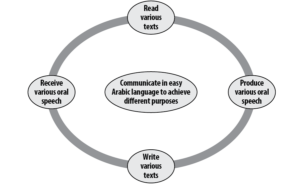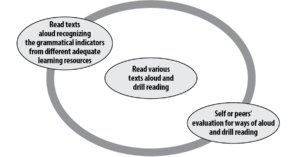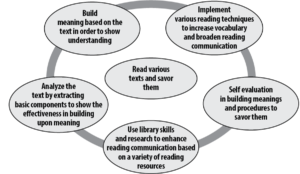Language/Reading Curriculum in the Fourth Grade
Reading Policy
The presence of the Arabic language in the Kingdom of Bahrain’s basic education curriculum depends on the integration of two dimensions. The first dimension treats the Arabic language as a learning subject and as a part of the Learning Languages domain. The second dimension treats Arabic as a language of teaching and as a transitional channel for students in basic education that allows them to build on their theoretical and technical understanding of scientific, social, religious, artistic, and emotional experiences and in all other subjects and areas of learning. Based on these facts, the Arabic language national curriculum, which has been in effect since 2009, was reformed and the onset of developing the national Arabic language curriculum commenced during the 2013–2014 school year. A selection of textbooks was revised and portions within were replaced in order to develop them; for example, 20 percent of the texts in the Grade 4 reading textbook were adjusted.
Summary of National Curriculum
The characteristics of the two aforementioned dimensions of the Arabic language directed all development attempts toward the Arabic language basic education curriculum. Therefore, the Arabic language developed curriculum was built on a number of philosophical, legislative, social, psychological, contextual, and scientific perspectives including educational approaches pertaining to literacy. These approaches led to adopting a literacy concept that depends on “owning the individual, the appropriate competencies to understand the texts analyzed, interpret and produce them in different contexts.”11 In adopting the literacy concept, the topics in the Arabic Language developed curriculum for basic education were built on enabling the learner to acquire the language from one perspective and to use it as a tool to obtain the remaining subjects from another perspective. In general, the Arabic language curriculum for basic education focuses on four domains: Listening, Speaking, Reading, and Writing. These domains can be categorized into two classifications: Receiving (listening and reading) and Production (speaking and writing). The second classification includes Orality (speaking and listening) and Writing (reading and writing). This perspective works on the integration of the four domains in assisting learners with acquiring the skills and experiences that qualify them to understand the language and use it in a variety of contexts based on their aims and needs.
The Reading domain is considered fundamental for the Bahrain national curriculum in the learning of the Arabic language. The texts in the curricular document are arranged clearly into two classifications; the first encompasses texts arranged by genre (e.g., recitative, debatable, informative, and dialogued texts) to impact the learner’s ability and experience and to classify the texts they read as a base in understanding literary forms and semantic fields. The second classification is the arrangement of the texts in units covering significant topics related to everyday life (e.g., school, environment, family, country) in order to broaden learnersʼ knowledge and help them become enthusiastic toward reading. The Ministry of Education is updating Arabic textbooks to follow the aforementioned descriptions of the curricular document, which connects reading with the other communication skills in the Arabic language (receiving and producing) and the other three domains (Listening, Writing, and Speaking).
By the end of basic education, students are expected to have achieved the objectives of the following three areas:
- Values, Behavior, and Attitude—Students should strengthen their faith in Islamic belief, its principles, and noble purposes and be embraced by their values and magnanimous education. They should be enthusiastic in their loyalty to Bahrain, be keen on its progression, and strengthen and protect their national, Gulf, Arabic, and Islamic identity, realizing the Arabic languageʼs ability in comprehending the latest knowledge and producing solutions, abiding by positive dialogue and respecting rules set forth in a group. They also should be open and positive, which enables them to interact with others in a balanced manner, and to acquire the aspiration to continue learning all their lives.
- Knowledge—Students should deepen their awareness of the Arabic languageʼs core system in producing and receiving oral and written Arabic proceeding from using the significant status and speech contexts. They should acquire the correct critical and successful methods of thinking and increase their awareness of the principles of dealing with communication technology and learn and benefit from them. They should deepen their awareness in reading a diversified patterned and structured text and gradually develop from simple to complex texts.
- Abilities and Skills—Students should communicate in easy Arabic language and demonstrate their linguistic acquisitions in expressing various daily life events according to significant communication situations; attain appropriate competencies that enable them to produce different patterned complex or noncomplex descriptive, recitative, or debatable texts; increase their research and survey abilities and deal with different learning resources such as books, dictionaries, encyclopedias, websites; develop their creative and talented abilities to enable them to produce a literary output up to their standards (e.g., short story, play, article, poem), savoring the beauty contained within the listened or read speech of images and fantasies to highlight the meaning; and use communication techniques easily in communicating and learning aspects and earn the ability to evaluate, criticize, and persuade.
The general objectives of the national curriculum for Grade 4 Arabic language (which are the objectives of Cycle 2 of basic education) are specified according to the four aforementioned domains:
- Speaking—In oral communication, it is expected that the student be committed to dialogue, discussion, and query etiquette; express ideas, feelings, and emotions clearly, confidently, and fluently; and demonstrate their speaking ability in order to evaluate the content of oral communication.
- Listening—Students should be able to apply listening rules and etiquette in different situations; use communicative skills and abilities in comprehending and analyzing speeches, and evaluate any audible speech.
- Reading—The national curriculum concentrates on two types of reading: reading aloud and silent reading. Exhibits 1 and 2 show the competency components and objectives that Grade 4 students should attain in reading aloud and in silent reading.
- Writing—Students should be able to demonstrate spelling skills by writing various texts in the appropriate manner; produce short texts with different purposes according to a variety of communication situations; produce different creative texts, employing basic writing processes in producing written formatted text; and use self-evaluation for text procedures and production.
Exhibit 1: Reading Aloud Competencies and Objectives for Grade 4 Students
| Competencies | Objectives |
| Read aloud various texts accurately, considering grammatical and linguistic rules | Students should be able to read texts aloud accurately and express the meaning depending on their prior linguistic ability; be committed in their reading aloud performance to the correct letters and word pronunciation, understand the meaning of what is read; read texts fluently and accurately, representing the correct links and stops when reading and taking into account the unitsʼ meanings; relate their reading of texts to appropriate nonlinguistics media suitable for reading for communication (e.g., pointing, nodding, facial expressions); and diversify their sound reading rhythms according to posture and status. |
| Self-evaluation and evaluation of peers as readers | Student should be able to identify grammar errors in what they read and correct them; recognize grammar errors in peersʼ reading and participate in correcting them; specify the points of strength in their reading performance and develop them; determine the weakness points in their reading performance and try to avoid them; and develop their own reading performance by benefiting from comments and critique. |
Exhibit 2: Silent Reading Competencies and Objectives for Grade 4 Students
| Competencies | Objectives |
| Build meaning of the text to show comprehension of reading communication situation | Students should be able to use prereading strategies in predicting the content through clues (e.g., genre, title, illustrations, writing); employ different reading strategies to analyze and understand texts (e.g., determine key words, identify meanings of new words, use new words in different meaningful contexts, conclude the general idea, classify ideas into main and subideas and show their relationships, balance between predictions and the text content, arrange ideas and events according to their importance from their own point of view giving a reason); specify the writerʼs purposes according to accurate technical and contextual evidence; specify some of the beauty aspects in the passage and give reasons; classify characters into major and minor; and distinguish between facts and given opinions in the passage. |
| Implement various reading techniques in order to increase vocabulary and broaden reading communication | Students should be able to specify the meaning of words through induction, context indicators, and synonym and antonym relationships; classify a group of words according to their connection to a well-defined semantic field; and use simplified dictionaries to explore vocabulary meaning. |
| Analyze reading text structure by extracting the textʼs basic components to show their effectiveness in building text meaning | Students should be able to analyze the narrative text structure into its components (e.g., characters, settings, events), realizing interrelatedness among them; analyze the descriptive text structure by specifying the described element and aspects of description; invest linguistic knowledge and experiences in extracting implicit and explicit text meanings; create appropriate questions related to the text; demonstrate verses of poetry or a paragraph within an idea they have read; compare ideas or opinions in the reading text and coinciding texts; and construct reasons and enrich the text with new appropriate ideas. |
| Use library and research skills to enhance reading communication depending on a variety of reading resources | The student should be able to use tables, graphs, and maps to conclude specific information; employ resources such as books, newspapers, simple encyclopedia, and webpages to be entertained and get useful information; apply appropriate electronic search tools to extract information for any topic; and use the library card appropriately with the teacherʼs help. |
| Self-evaluation in building meanings and procedures and savoring them | The student should be able to give judgment in light of analyzing the text, providing reasons; compare between the reading output and their purposes; modify and enhance their reading strategies in light of their qualities and faults; and develop reading performance by benefiting from comments and critique. |
The following exhibits show the reading structure and interrelatedness with other Arabic learning domains, the components of the reading aloud competency, and the components of the silent reading competency.
Exhibit 3: Reading Structure Interrelatedness Among Other Learning Arabic Domains

Exhibit 4: Components of the Reading Aloud Competency

Exhibit 5: Components of the Silent Reading Competency

